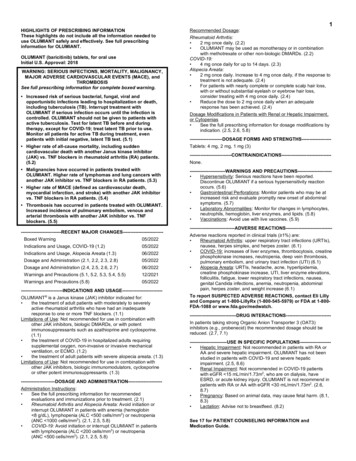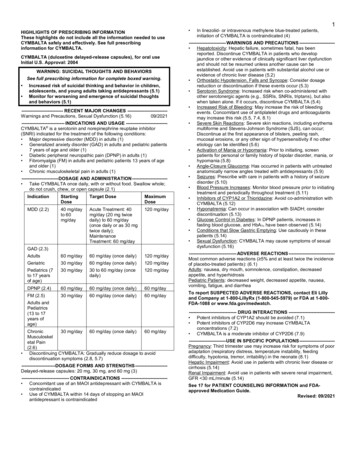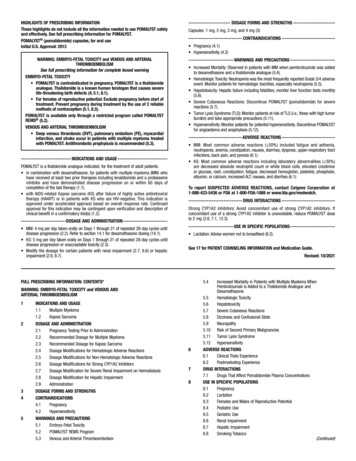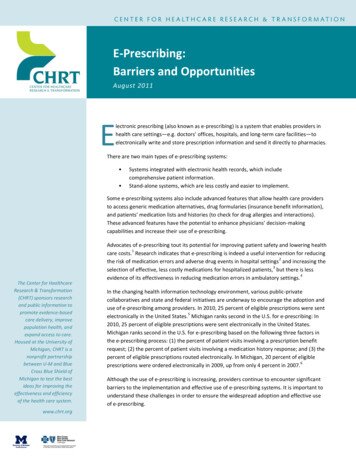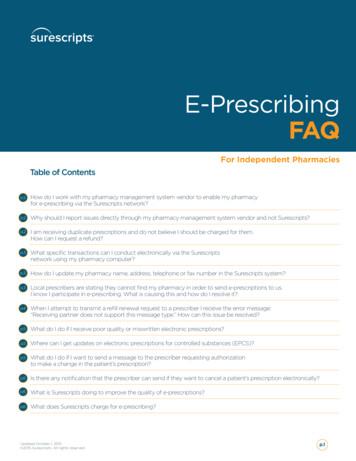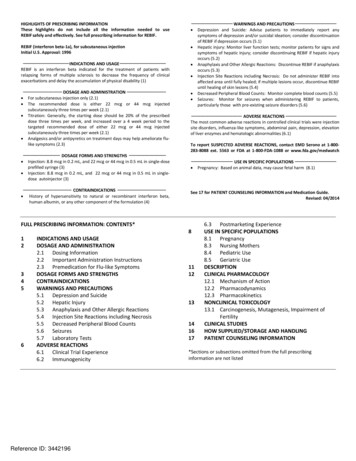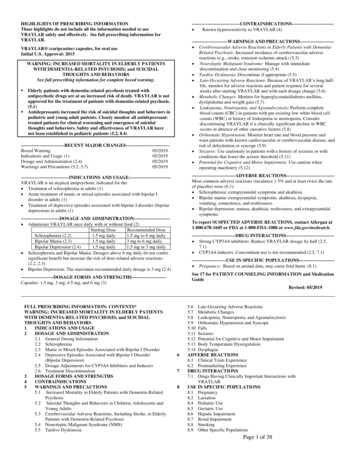
Transcription
HIGHLIGHTS OF PRESCRIBING INFORMATIONThese highlights do not include all the information needed to useVRAYLAR safely and effectively. See full prescribing information DICATIONS-------------------------- Known hypersensitivity to VRAYLAR (4)-----------------------WARNINGS AND PRECAUTIONS--------------------- Cerebrovascular Adverse Reactions in Elderly Patients with DementiaRelated Psychosis: Increased incidence of cerebrovascular adversereactions (e.g., stroke, transient ischemic attack) (5.3) Neuroleptic Malignant Syndrome: Manage with immediatediscontinuation and close monitoring (5.4) Tardive Dyskinesia: Discontinue if appropriate (5.5) Late-Occurring Adverse Reactions: Because of VRAYLAR’s long halflife, monitor for adverse reactions and patient response for severalweeks after starting VRAYLAR and with each dosage change (5.6) Metabolic Changes: Monitor for hyperglycemia/diabetes mellitus,dyslipidemia and weight gain (5.7) Leukopenia, Neutropenia, and Agranulocytosis: Perform completeblood counts (CBC) in patients with pre-existing low white blood cellcounts (WBC) or history of leukopenia or neutropenia. Considerdiscontinuing VRAYLAR if a clinically significant decline in WBCoccurs in absence of other causative factors (5.8) Orthostatic Hypotension: Monitor heart rate and blood pressure andwarn patients with known cardiovascular or cerebrovascular disease, andrisk of dehydration or syncope (5.9) Seizures: Use cautiously in patients with a history of seizures or withconditions that lower the seizure threshold (5.11) Potential for Cognitive and Motor Impairment: Use caution whenoperating machinery (5.12)VRAYLAR (cariprazine) capsules, for oral useInitial U.S. Approval: 2015WARNING: INCREASED MORTALITY IN ELDERLY PATIENTSWITH DEMENTIA-RELATED PSYCHOSIS; and SUICIDALTHOUGHTS AND BEHAVIORSSee full prescribing information for complete boxed warning. Elderly patients with dementia-related psychosis treated withantipsychotic drugs are at an increased risk of death. VRAYLAR is notapproved for the treatment of patients with dementia-related psychosis.(5.1)Antidepressants increased the risk of suicidal thoughts and behaviors inpediatric and young adult patients. Closely monitor all antidepressanttreated patients for clinical worsening and emergence of suicidalthoughts and behaviors. Safety and effectiveness of VRAYLAR havenot been established in pediatric patients (5.2, 8.4)----------------------------RECENT MAJOR CHANGES---------------------------Boxed Warning05/2019Indications and Usage (1)05/2019Dosage and Administration (2.4)05/2019Warnings and Precautions (5.2, 5.7)05/2019----------------------------ADVERSE REACTIONS------------------------------Most common adverse reactions (incidence 5% and at least twice the rateof placebo) were (6.1): Schizophrenia: extrapyramidal symptoms and akathisia Bipolar mania: extrapyramidal symptoms, akathisia, dyspepsia,vomiting, somnolence, and restlessness Bipolar depression: nausea, akathisia, restlessness, and ---INDICATIONS AND USAGE--------------------------VRAYLAR is an atypical antipsychotic indicated for the: Treatment of schizophrenia in adults (1) Acute treatment of manic or mixed episodes associated with bipolar Idisorder in adults (1) Treatment of depressive episodes associated with bipolar I disorder (bipolardepression) in adults (1)-------------------------DOSAGE AND ADMINISTRATION---------------------- Administer VRAYLAR once daily with or without food (2)Starting DoseRecommended DoseSchizophrenia (2.2)1.5 mg daily1.5 mg to 6 mg dailyBipolar Mania (2.3)1.5 mg daily3 mg to 6 mg dailyBipolar Depression (2.4)1.5 mg daily1.5 mg or 3 mg daily Schizophrenia and Bipolar Mania: Dosages above 6 mg daily do not confersignificant benefit but increase the risk of dose-related adverse reactions(2.2, 2.3) Bipolar Depression: The maximum recommended daily dosage is 3 mg (2.4)To report SUSPECTED ADVERSE REACTIONS, contact Allergan at1-800-678-1605 or FDA at 1-800-FDA-1088 or RUG INTERACTIONS------------------------------ Strong CYP3A4 inhibitors: Reduce VRAYLAR dosage by half (2.5,7.1) CYP3A4 inducers: Concomitant use is not recommended (2.5, 7.1)----------------------USE IN SPECIFIC POPULATIONS---------------------- Pregnancy: Based on animal data, may cause fetal harm. (8.1)See 17 for PATIENT COUNSELING INFORMATION and MedicationGuide---------------------DOSAGE FORMS AND STRENGTHS---------------------Capsules: 1.5 mg, 3 mg, 4.5 mg, and 6 mg (3)Revised: 05/2019FULL PRESCRIBING INFORMATION: CONTENTS*WARNING: INCREASED MORTALITY IN ELDERLY PATIENTSWITH DEMENTIA-RELATED PSYCHOSIS; and SUICIDALTHOUGHTS AND BEHAVIORS1INDICATIONS AND USAGE2DOSAGE AND ADMINISTRATION2.1 General Dosing Information2.2 Schizophrenia2.3 Manic or Mixed Episodes Associated with Bipolar I Disorder2.4 Depressive Episodes Associated with Bipolar I Disorder(Bipolar Depression)2.5 Dosage Adjustments for CYP3A4 Inhibitors and Inducers2.6 Treatment Discontinuation3DOSAGE FORMS AND STRENGTHS4CONTRAINDICATIONS5WARNINGS AND PRECAUTIONS5.1 Increased Mortality in Elderly Patients with Dementia-RelatedPsychosis5.2 Suicidal Thoughts and Behaviors in Children, Adolescents andYoung Adults5.3 Cerebrovascular Adverse Reactions, Including Stroke, in ElderlyPatients with Dementia-Related Psychosis5.4 Neuroleptic Malignant Syndrome (NMS)5.5 Tardive Dyskinesia6785.6 Late-Occurring Adverse Reactions5.7 Metabolic Changes5.8 Leukopenia, Neutropenia, and Agranulocytosis5.9 Orthostatic Hypotension and Syncope5.10 Falls5.11 Seizures5.12 Potential for Cognitive and Motor Impairment5.13 Body Temperature Dysregulation5.14 DysphagiaADVERSE REACTIONS6.1 Clinical Trials Experience6.2 Postmarketing ExperienceDRUG INTERACTIONS7.1 Drugs Having Clinically Important Interactions withVRAYLARUSE IN SPECIFIC POPULATIONS8.1 Pregnancy8.2 Lactation8.4 Pediatric Use8.5 Geriatric Use8.6 Hepatic Impairment8.7 Renal Impairment8.8 Smoking8.9 Other Specific PopulationsPage 1 of 38
910111213DRUG ABUSE AND DEPENDENCE9.1 Controlled Substance9.2 Abuse9.3 DependenceOVERDOSAGE10.1 Human Experience10.2 Management of OverdosageDESCRIPTIONCLINICAL PHARMACOLOGY12.1 Mechanism of Action12.2 Pharmacodynamics12.3 PharmacokineticsNONCLINICAL TOXICOLOGY13.1 Carcinogenesis, Mutagenesis, Impairment of Fertility13.2 Animal Toxicology and/or Pharmacology141617CLINICAL STUDIES14.1 Schizophrenia14.2 Manic or Mixed Episodes Associated with Bipolar I Disorder14.3 Depressive Episodes Associated with Bipolar I Disorder (BipolarDepression)HOW SUPPLIED/STORAGE AND HANDLING16.1 How Supplied16.2 Storage and HandlingPATIENT COUNSELING INFORMATION*Sections or subsections omitted from the full prescribing information arenot listedPage 2 of 38
FULL PRESCRIBING INFORMATIONWARNING: INCREASED MORTALITY IN ELDERLY PATIENTS WITH DEMENTIARELATED PSYCHOSIS; and SUICIDAL THOUGHTS AND BEHAVIORSIncreased Mortality in Elderly Patients with Dementia-Related PsychosisElderly patients with dementia-related psychosis treated with antipsychotic drugs are at anincreased risk of death. VRAYLAR is not approved for the treatment of patients with dementiarelated psychosis [see Warnings and Precautions (5.1)].Suicidal Thoughts and BehaviorsAntidepressants increased the risk of suicidal thoughts and behaviors in pediatric and young adultpatients in short-term studies. Closely monitor all antidepressant-treated patients for clinical worsening,and for the emergence of suicidal thoughts and behaviors [see Warnings and Precautions (5.2)]. The safetyand effectiveness of VRAYLAR have not been established in pediatric patients [see Use in SpecificPopulations (8.4)].1.INDICATIONS AND USAGEVRAYLAR is indicated for the: 2.Treatment of schizophrenia in adults [see Clinical Studies (14.1)]Acute treatment of manic or mixed episodes associated with bipolar I disorder in adults [seeClinical Studies (14.2)]Treatment of depressive episodes associated with bipolar I disorder (bipolar depression) in adults[see Clinical Studies (14.3)]DOSAGE AND ADMINISTRATION2.1General Dosing InformationVRAYLAR is given orally once daily and can be taken with or without food.Because of the long half-life of cariprazine and its active metabolites, changes in dose will not be fullyreflected in plasma for several weeks. Prescribers should monitor patients for adverse reactions andtreatment response for several weeks after starting VRAYLAR and after each dosage change [seeWarnings and Precautions (5.6), Clinical Pharmacology (12.3)].2.2SchizophreniaThe recommended dosage range is 1.5 mg to 6 mg once daily. The starting dosage of VRAYLAR is 1.5mg daily. The dosage can be increased to 3 mg on Day 2. Depending upon clinical response and tolerability,further dose adjustments can be made in 1.5 mg or 3 mg increments. The maximum recommended dosageis 6 mg daily. In short-term controlled trials, dosages above 6 mg daily do not confer increasedeffectiveness sufficient to outweigh dose-related adverse reactions [see Adverse Reactions (6.1), ClinicalStudies (14.1)].2.3Manic or Mixed Episodes Associated with Bipolar I DisorderThe recommended dosage range is 3 mg to 6 mg once daily. The starting dose of VRAYLAR is 1.5 mgand should be increased to 3 mg on Day 2. Depending upon clinical response and tolerability, further doseadjustments can be made in 1.5 mg or 3 mg increments. The maximum recommended dosage is 6 mg daily.Page 3 of 38
In short-term controlled trials, dosages above 6 mg daily do not confer increased effectiveness sufficientto outweigh dose-related adverse reactions [see Adverse Reactions (6.1), Clinical Studies (14.2)].2.4Depressive Episodes Associated with Bipolar I Disorder (Bipolar Depression)The starting dose of VRAYLAR is 1.5 mg once daily. Depending upon clinical response and tolerability,the dosage can be increased to 3 mg once daily on Day 15. Maximum recommended dosage is 3 mg oncedaily.2.5Dosage Adjustments for CYP3A4 Inhibitors and InducersCYP3A4 is responsible for the formation and elimination of the major active metabolites of cariprazine.Dosage recommendation for patients initiating a strong CYP3A4 inhibitor while on a stable dose ofVRAYLAR: If a strong CYP3A4 inhibitor is initiated, reduce the current dosage of VRAYLAR by half. Forpatients taking 4.5 mg daily, the dosage should be reduced to 1.5 mg or 3 mg daily. For patients taking1.5 mg daily, the dosing regimen should be adjusted to every other day. When the CYP3A4 inhibitor iswithdrawn, VRAYLAR dosage may need to be increased [see Drug Interactions (7.1)].Dosage recommendation for patients initiating VRAYLAR therapy while already on a strong CYP3A4inhibitor: Patients should be administered 1.5 mg of VRAYLAR on Day 1 and on Day 3 with no doseadministered on Day 2. From Day 4 onward, the dose should be administered at 1.5 mg daily, thenincreased to a maximum dose of 3 mg daily. When the CYP3A4 inhibitor is withdrawn, VRAYLARdosage may need to be increased [see Drug Interactions (7.1)].Dosage recommendation for patients concomitantly taking VRAYLAR with CYP3A4 inducers:Concomitant use of VRAYLAR and a CYP3A4 inducer has not been evaluated and is not recommendedbecause the net effect on active drug and metabolites is unclear [see Dosage and Administration (2.1),Warnings and Precautions (5.6), Drug Interactions (7.1), Clinical Pharmacology (12.3)].2.6Treatment DiscontinuationFollowing discontinuation of VRAYLAR, the decline in plasma concentrations of active drug andmetabolites may not be immediately reflected in patients’ clinical symptoms; the plasma concentration ofcariprazine and its active metabolites will decline by 50% in 1 week [see Clinical Pharmacology (12.3)].There are no systematically collected data to specifically address switching patients from VRAYLAR toother antipsychotics or concerning concomitant administration with other antipsychotics.3.DOSAGE FORMS AND STRENGTHSVRAYLAR (cariprazine) capsules are available in four strengths. 4.1.5 mg capsules: White cap and body imprinted with “FL 1.5”3 mg capsules: Green to blue-green cap and white body imprinted with “FL 3”4.5 mg capsules: Green to blue-green cap and body imprinted with “FL 4.5”6 mg capsules: Purple cap and white body imprinted with “FL 6”CONTRAINDICATIONSVRAYLAR is contraindicated in patients with history of a hypersensitivity reaction to cariprazine.Reactions have ranged from rash, pruritus, urticaria, and events suggestive of angioedema (e.g., swollentongue, lip swelling, face edema, pharyngeal edema, and swelling face).Page 4 of 38
5.WARNINGS AND PRECAUTIONS5.1Increased Mortality in Elderly Patients with Dementia-Related PsychosisAntipsychotic drugs increase the all-cause risk of death in elderly patients with dementia-related psychosis.Analyses of 17 dementia-related psychosis placebo-controlled trials (modal duration of 10 weeks andlargely in patients taking atypical antipsychotic drugs) revealed a risk of death in the drug-treated patientsof between 1.6 to 1.7 times that in placebo-treated patients. Over the course of a typical 10-week controlledtrial, the rate of death in drug-treated patients was about 4.5%, compared to a rate of about 2.6% in placebotreated patients.Although the causes of death were varied, most of the deaths appeared to be either cardiovascular (e.g.,heart failure, sudden death) or infectious (e.g., pneumonia) in nature. VRAYLAR is not approved for thetreatment of patients with dementia-related psychosis [see Boxed Warning, Warnings and Precautions(5.3)].5.2Suicidal Thoughts and Behaviors in Children, Adolescents and Young AdultsIn pooled analyses of placebo-controlled trials of antidepressant drugs (SSRIs and other antidepressantclasses) that included approximately 77,000 adult patients and 4,500 pediatric patients, the incidence ofsuicidal thoughts and behaviors in antidepressant-treated patients age 24 years and younger was greaterthan in placebo-treated patients. There was considerable variation in risk of suicidal thoughts andbehaviors among drugs, but there was an increased risk identified in young patients for most drugsstudied. There were differences in absolute risk of suicidal thoughts and behaviors across the differentindications, with the highest incidence in patients with MDD. The drug-placebo differences in thenumber of cases of suicidal thoughts and behaviors per 1000 patients treated are provided in Table 1.Table 1: Risk Differences of the Number of Patients of Suicidal Thoughts and Behavior in thePooled Placebo-Controlled Trials of Antidepressants in Pediatric* and Adult PatientsAge Range 18 years old18-24 years old25-64 years old 65 years oldDrug-Placebo Difference in Number of Patients of SuicidalThoughts or Behaviors per 1000 Patients TreatedIncreases Compared to Placebo14 additional patients5 additional patientsDecreases Compared to Placebo1 fewer patient6 fewer patients* Vraylar is not approved for use in pediatric patients.It is unknown whether the risk of suicidal thoughts and behaviors in children, adolescents, and youngadults extends to longer-term use, i.e., beyond four months. However, there is substantial evidence fromplacebo-controlled maintenance trials in adults with MDD that antidepressants delay the recurrence ofdepression and that depression itself is a risk factor for suicidal thoughts and behaviors.Monitor all antidepressant-treated patients for any indication for clinical worsening and emergence ofsuicidal thoughts and behaviors, especially during the initial few months of drug therapy, and at times ofdosage changes. Counsel family members or caregivers of patients to monitor for changes in behaviorand to alert the healthcare provider. Consider changing the therapeutic regimen, including possiblydiscontinuing VRAYLAR, in patients whose depression is persistently worse, or who are experiencingemergent suicidal thoughts or behaviors.Page 5 of 38
5.3Cerebrovascular Adverse Reactions, Including Stroke, in Elderly Patients withDementia-Related PsychosisIn placebo-controlled trials in elderly subjects with dementia, patients randomized to risperidone,aripiprazole, and olanzapine had a higher incidence of stroke and transient ischemic attack, including fatalstroke. VRAYLAR is not approved for the treatment of patients with dementia-related psychosis [seeBoxed Warning, Warnings and Precautions (5.1)].5.4Neuroleptic Malignant Syndrome (NMS)Neuroleptic Malignant Syndrome (NMS), a potentially fatal symptom complex, has been reported inassociation with administration of antipsychotic drugs. Clinical manifestations of NMS are hyperpyrexia,muscle rigidity, delirium, and autonomic instability. Additional signs may include elevated creatinephosphokinase, myoglobinuria (rhabdomyolysis), and acute renal failure.If NMS is suspected, immediately discontinue VRAYLAR and provide intensive symptomatic treatmentand monitoring.5.5Tardive DyskinesiaTardive dyskinesia, a syndrome consisting of potentially irreversible, involuntary, dyskinetic movements,may develop in patients treated with antipsychotic drugs, including VRAYLAR. The risk appears to behighest among the elderly, especially elderly women, but it is not possible to predict which patients arelikely to develop the syndrome. Whether antipsychotic drug products differ in their potential to causetardive dyskinesia is unknown.The risk of tardive dyskinesia and the likelihood that it will become irreversible increase with the durationof treatment and the cumulative dose. The syndrome can develop after a relatively brief treatment period,even at low doses. It may also occur after discontinuation of treatment.Tardive dyskinesia may remit, partially or completely, if antipsychotic treatment is discontinued.Antipsychotic treatment itself, however, may suppress (or partially suppress) the signs and symptoms ofthe syndrome, possibly masking the underlying process. The effect that symptomatic suppression has uponthe long-term course of tardive dyskinesia is unknown.Given these considerations, VRAYLAR should be prescribed in a manner most likely to reduce the risk oftardive dyskinesia. Chronic antipsychotic treatment should generally be reserved for patients: 1) who sufferfrom a chronic illness that is known to respond to antipsychotic drugs; and 2) for whom alternative,effective, but potentially less harmful treatments are not available or appropriate. In patients who do requirechronic treatment, use the lowest dose and the shortest duration of treatment producing a satisfactoryclinical response should be sought. Periodically reassess the need for continued treatment.If signs and symptoms of tardive dyskinesia appear in a patient on VRAYLAR, drug discontinuationshould be considered. However, some patients may require treatment with VRAYLAR despite thepresence of the syndrome.5.6Late-Occurring Adverse ReactionsAdverse events may first appear several weeks after the initiation of VRAYLAR treatment, probablybecause plasma levels of cariprazine and its major metabolites accumulate over time. As a result, theincidence of adverse reactions in short-term trials may not reflect the rates after longer term exposures[see Dosage and Administration (2.1), Adverse Reactions (6.1), Clinical Pharmacology (12.3)].Page 6 of 38
Monitor for adverse reactions, including extrapyramidal symptoms (EPS) or akathisia, and patientresponse for several weeks after a patient has begun VRAYLAR and after each dosage increase.Consider reducing the dose or discontinuing the drug.5.7Metabolic ChangesAtypical antipsychotic drugs, including VRAYLAR, have caused metabolic changes, includinghyperglycemia, diabetes mellitus, dyslipidemia, and weight gain. Although all of the drugs in the class todate have been shown to produce some metabolic changes, each drug has its own specific risk profile.Hyperglycemia and Diabetes MellitusHyperglycemia, in some cases extreme and associated with ketoacidosis or hyperosmolar coma or death,has been reported in patients treated with atypical antipsychotics. Assess fasting plasma glucose before orsoon after initiation of antipsychotic medication, and monitor periodically during long-term treatment.SchizophreniaIn the 6-week, placebo-controlled trials of adult patients with schizophrenia, the proportion of patients withshifts in fasting glucose from normal ( 100 mg/dL) to high ( 126 mg/dL) and borderline ( 100 and 126 mg/dL) to high were similar in patients treated with VRAYLAR and placebo. In the long-term, openlabel schizophrenia studies, 4% patients with normal hemoglobin A1c baseline values developed elevatedlevels ( 6.5%).Bipolar DisorderIn six placebo-controlled trials up to 8-weeks of adult patients with bipolar disorder (mania or depression),the proportion of patients with shifts in fasting glucose from normal ( 100 mg/dL) to high ( 126 mg/dL)and borderline ( 100 and 126 mg/dL) to high were similar in patients treated with VRAYLAR andplacebo. In the long-term, open-label bipolar disorder studies, 4% patients with normal hemoglobin A1cbaseline values developed elevated levels ( 6.5%).DyslipidemiaAtypical antipsychotics cause adverse alterations in lipids. Before or soon after initiation of antipsychoticmedication, obtain a fasting lipid profile at baseline and monitor periodically during treatment.SchizophreniaIn the 6-week, placebo-controlled trials of adult patients with schizophrenia, the proportion of patientswith shifts in fasting total cholesterol, LDL, HDL and triglycerides were similar in patients treated withVRAYLAR and placebo.Bipolar DisorderIn six placebo-controlled trials up to 8-weeks of adult patients with bipolar disorder (mania or depression),the proportion of patients with shifts in fasting total cholesterol, LDL, HDL and triglycerides were similarin patients treated with VRAYLAR and placebo.Weight GainWeight gain has been observed with use of atypical antipsychotics, including VRAYLAR. Monitor weightat baseline and frequently thereafter. Tables 2, 3, and 4 show the change in body weight occurring frombaseline to endpoint in 6-week schizophrenia, 3-week bipolar mania, and 6-week and 8-week bipolardepression trials, respectively.Page 7 of 38
Table 2. Change in Body Weight (kg) in 6-Week Schizophrenia TrialsPlacebo(N 573) 0.3Mean Change at EndpointProportion of Patients with Weight Increase ( 7%)5%1.5 - 3mg/day(N 512) 0.88%VRAYLAR*4.5 - 69 - 12⸰mg/daymg/day(N 570)(N 203) 1 18%17%*Data shown by modal daily dose, defined as most frequently administered dose per patient⸰The maximum recommended daily dose is 6 mg. Doses above 6 mg daily do not confer increased effectiveness sufficient tooutweigh dose-related adverse reactions.In long-term, uncontrolled trials with VRAYLAR in schizophrenia, the mean changes from baseline inweight at 12, 24, and 48 weeks were 1.2 kg, 1.7 kg, and 2.5 kg, respectively.Table 3. Change in Body Weight (kg) in 3-Week Bipolar Mania TrialsPlacebo(N 439)Mean Change at EndpointProportion of Patients with Weight Increase ( 7%) 0.22%VRAYLAR*3-69 - 12⸰mg/daymg/day(N 259)(N 360) 0.5 0.61%3%*Data shown by modal daily dose, defined as most frequently administered dose per patient⸰The maximum recommended daily dose is 6 mg. Doses above 6 mg daily do not confer increased effectiveness sufficient tooutweigh dose-related adverse reactions.Table 4. Change in Body Weight (kg) in two 6-Week and one 8-Week Bipolar Depression TrialsMean Change at EndpointProportion of Patients with Weight Increase ( 7%)Placebo(N 463)-0.11%VRAYLAR1.5 mg/day3 mg/day(N 467)(N 465) 0.4 0.73%3%5.8Leukopenia, Neutropenia, and AgranulocytosisLeukopenia and neutropenia have been reported during treatment with antipsychotic agents, includingVRAYLAR. Agranulocytosis (including fatal cases) has been reported with other agents in the class.Possible risk factors for leukopenia and neutropenia include pre-existing low white blood cell count (WBC)or absolute neutrophil count (ANC) and history of drug-induced leukopenia or neutropenia. In patientswith a pre-existing low WBC or ANC or a history of drug-induced leukopenia or neutropenia, perform acomplete blood count (CBC) frequently during the first few months of therapy. In such patients, considerdiscontinuation of VRAYLAR at the first sign of a clinically significant decline in WBC in the absence ofother causative factors.Page 8 of 38
Monitor patients with clinically significant neutropenia for fever or other symptoms or signs of infectionand treat promptly if such symptoms or signs occur. Discontinue VRAYLAR in patients with absoluteneutrophil count 1000/mm3 and follow their WBC until recovery.5.9Orthostatic Hypotension and SyncopeAtypical antipsychotics cause orthostatic hypotension and syncope. Generally, the risk is greatest duringinitial dose titration and when increasing the dose. Symptomatic orthostatic hypotension was infrequent intrials of VRAYLAR and was not more frequent on VRAYLAR than placebo. Syncope was not observed.Orthostatic vital signs should be monitored in patients who are vulnerable to hypotension (e.g., elderlypatients, patients with dehydration, hypovolemia, and concomitant treatment with antihypertensivemedications), patients with known cardiovascular disease (history of myocardial infarction, ischemic heartdisease, heart failure, or conduction abnormalities), and patients with cerebrovascular disease. VRAYLARhas not been evaluated in patients with a recent history of myocardial infarction or unstable cardiovasculardisease. Such patients were excluded from pre-marketing clinical trials.5.10FallsAntipsychotics, including VRAYLAR, may cause somnolence, postural hypotension, motor and sensoryinstability, which may lead to falls and, consequently, fractures or other injuries. For patients withdiseases, conditions, or medications that could exacerbate these effects, complete fall risk assessmentswhen initiating antipsychotic treatment and recurrently for patients on long-term antipsychotic therapy.5.11SeizuresLike other antipsychotic drugs, VRAYLAR may cause seizures. This risk is greatest in patients with ahistory of seizures or with conditions that lower the seizure threshold. Conditions that lower the seizurethreshold may be more prevalent in older patients.5.12Potential for Cognitive and Motor ImpairmentVRAYLAR, like other antipsychotics, has the potential to impair judgment, thinking, or motor skills.In 6-week schizophrenia trials, somnolence (hypersomnia, sedation, and somnolence) was reported in 7%of VRAYLAR-treated patients compared to 6% of placebo-treated patients. In 3-week bipolar mania trials,somnolence was reported in 8% of VRAYLAR-treated patients compared to 4% of placebo-treatedpatients.Patients should be cautioned about operating hazardous machinery, including motor vehicles, until theyare reasonably certain that therapy with VRAYLAR does not affect them adversely.5.13Body Temperature DysregulationAtypical antipsychotics may disrupt the body’s ability to reduce core body temperature. Strenuousexercise, exposure to extreme heat, dehydration, and anticholinergic medications may contribute to anelevation in core body temperature; use VRAYLAR with caution in patient who may experience theseconditions.5.14DysphagiaEsophageal dysmotility and aspiration have been associated with antipsychotic drug use. Dysphagia hasbeen reported with VRAYLAR. VRAYLAR and other antipsychotic drugs should be used cautiously inpatients at risk for aspiration.Page 9 of 38
6ADVERSE REACTIONSThe following adverse reactions are discussed in more detail in other sections of the labeling: Increased Mortality in Elderly Patients with Dementia-Related Psychosis [see Boxed Warning andWarnings and Precautions (5.1)]Suicidal Thoughts and Behaviors [see Boxed Warning and Warnings and Precautions (5.2)]Cerebrovascular Adverse Reactions, Including Stroke, in Elderly Patients with Dementia-RelatedPsychosis [see Warnings and Precautions (5.3)]Neuroleptic Malignant Syndrome [see Warnings and Precautions (5.4)]Tardive Dyskinesia [see Warnings and Precautions (5.5)]Late Occurring Adverse Reactions [see Warnings and Precautions (5.6)]Metabolic Changes [see Warnings and Precautions (5.7)]Leukopenia, Neutropenia, and Agranulocytosis [see Warnings and Precautions (5.8)]Orthostatic Hypotension and Syncope [see Warnings and Precautions (5.9)]Falls [see Warnings and Precautions (5.10)]Seizures [see Warnings and Precautions (5.11)]Potential for Cognitive and Motor Impairment [see Warnings and Precautions (5.12)]Body Temperature Dysregulation [see Warnings and Precautions (5.13)]Dysphagia [see Warnings and Precautions (5.14)]6.1Clinical Trials ExperienceBecause clinical trials are conducted under widely varying conditions, adverse reaction rates observed inthe clinical trials of a drug cannot be directly compared to rates in the clinical trials of another drug andmay not reflect the rates observed in practice.The information below is derived from an integrated clinical study database for VRAYLAR consisting of4753 adult patients exposed to one or more doses of VRAYLAR for the treatment of schizophrenia, manicor mixed episodes associated with bipolar I disorder, and bipolar depression in placebo-controlled studies.This experience corresponds with a total experience of 940.3 patient-years. A total of 2568 VRAYLARtreated patients had at least 6 weeks and 296 VRAYLAR-treated patients had at least 48 weeks of exposure.Patients with SchizophreniaThe following findings are based on four placebo-controlled, 6-week schizophrenia trials with VRAYLARdoses ranging from 1.5 to 12 mg once daily. The maximum recommended dosage is 6 mg daily.Adverse Reactions Associated with Discontinuation of Treatment: There was no single adverse reactionleading to discontinuation that occurred at a rate of 2% in VRAYLAR-treated patients and at least twicethe rate of placebo.Common Adverse Reactions ( 5% a
Schizophrenia (2.2) 1.5 mg daily 1.5 mg to 6 mg daily Bipolar Mania (2.3) 1.5 mg daily 3 mg to 6 mg daily Bipolar Depression (2.4) 1.5 mg daily 1.5 mg or 3 mg daily Schizophrenia and Bipolar Mania: Dosages above 6 mg daily do not confer significant benefit but increase the risk of dose-related adverse reactions (2.2, 2.3)

